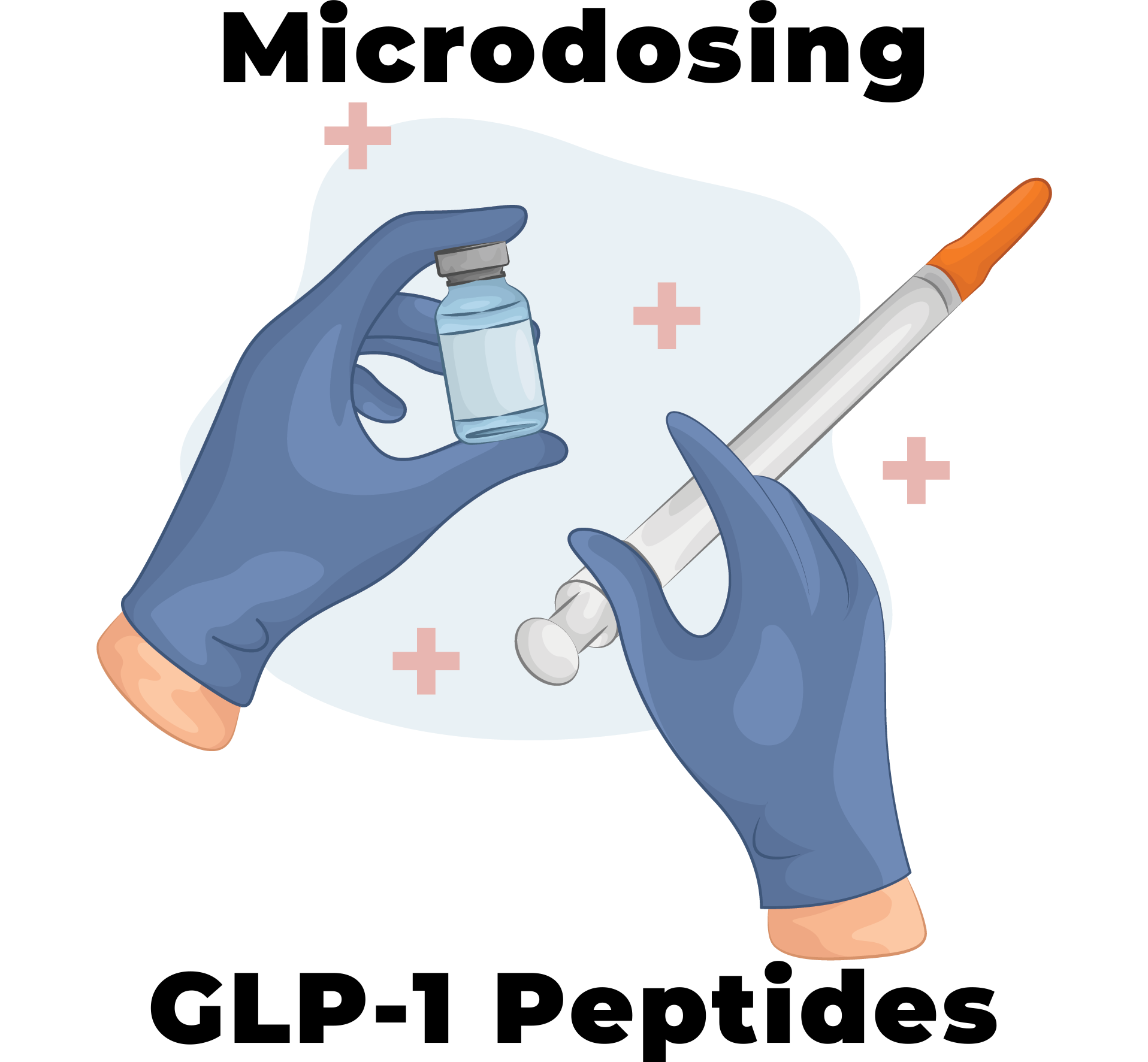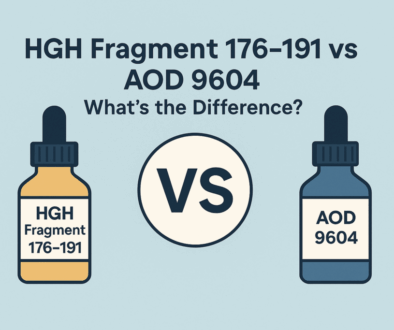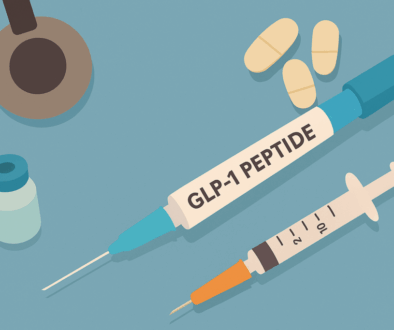Microdosing GLP-1 Peptides: A Detailed Guide

Microdosing GLP-1 peptides is a new trend in weight loss circles. It’s growing in popularity thanks to perceived benefits like a lower risk of side effects and preserving muscle mass.
But is microdosing worth it? And what kind of doses are used? Short answer: yes, microdosing can help minimize side effects while still promoting weight loss. But it’s not without its downsides.
Here’s what you need to know.
Quick Summary:
- Microdosing GLP-1 means taking smaller-than-prescribed doses of peptides like semaglutide and tirzepatide
- Microdosing is typically done to minimize the side effects of GLP-1 peptides
- Most doctors prefer to use standard doses but are open to microdosing, especially if their patients request it
Table Of Contents
What is Microdosing GLP-1s?
Microdosing is exactly what it sounds like: taking smaller-than-conventional doses of semaglutide, tirzepatide, or other GLP-1 peptides to promote steady weight loss with a lower risk of side effects.
For example, whereas a standard dose of tirzepatide is between 2.5 mg and 15 mg, a microdose might be 1 mg. Like regular doses, microdoses are typically taken once per week, although some people dose more frequently.
Benefits of Microdosing
- Fewer or no side effects
- Preserving lean body mass
- Lower costs
- Easier to adjust to the medication
- Getting other benefits (like lowering inflammation) without side effects
Microdosing GLP-1s has many potential benefits:
- Completely avoid the side effects or only experience mild ones.
- Standard doses of GLP-1s can often lead to massive weight loss. While this might sound good on paper, it can also mean that a person is losing muscle mass, which is detrimental to overall health. This is one of the reasons doctor Craig Koniver, a peptide specialist who appeared on the Huberman Lab podcast, likes to start his patients on microdoses and keep the weight loss below 2 lb/week.
- Saving money by using less of the peptide (at least initially).
- Working up to standard doses more safely since it gives the body time to adjust to the peptide.
- Another lesser-known use of microdosing is for non-weight-related benefits, like reducing inflammation or pain.
Some also choose to microdose GLP-1s to help maintain their weight after undergoing significant weight loss with regular doses, although the usefulness of this approach is debatable.
Downsides of Microdosing
- Reduced effectiveness
- Takes longer to see initial weight loss
- May be harder to dose
The biggest downside of microdosing GLP-1s is the reduced effectiveness: less and slower weight loss. Another overlooked downside of microdosing is that it makes it more difficult to measure and administer the dose:
- Peptides provided in a pen are harder to microdose since they come with pre-filled amounts
- Injectable peptides require careful measuring and come with a risk of contamination from repeat use
Did you know? The practice of microdosing originally referred to taking small amounts of psychedelic drugs, like LSD. The idea was that a person would take a small amount to experience some beneficial effects but not have to deal with the potential downsides. Since then, the practice of microdosing has spread to many other drugs and supplements.
Microdosing Semaglutide
Semaglutide (brand name Ozempic/Wegovy) is the most popular GLP-1 peptide. Microdosing semaglutide means starting with amounts below 0.25 mg, the standard starting dose.
Some people who use semaglutide as Ozempic do what’s called “counting clicks” because it comes in a pre-dosed pen. The basic idea is that a certain number of clicks corresponds to a lower dosage, like 9 clicks for 0.125 mg. This click-counting sheet by BC Children’s Hospital is a good example.
Join Our Newsletter — Get 15% Off
Get the latest offers, peptide research insights, and stock updates.
Did you know? GLP-1 peptides work by mimicking the natural GLP-1 hormone, which regulates blood sugar levels, appetite, and digestion.
Microdosing Tirzepatide
Tirzepatide (brand name Mounjaro/Zepbound) is a popular, newer-generation weight loss peptide. It’s dual-action, so it works not just on GLP-1 but another mechanism (glucose-dependent insulinotropic polypeptide or simply GIP).
Tirzepatide is typically started at 2.5 mg and gradually raised to a maximum dose of 15 mg. Meanwhile, typical microdoses are usually somewhere between 0.25 mg and 2 mg.
Example Protocol
A standard microdose schedule for tirzepatide might look something like this:
- Starting at 0.25 mg once a week for 1 month
- Raising by 0.25 mg every month, getting up to 1.5 mg after 6 months, and 3 mg after one year
Microdosing Retatrutide
Retatrutide is the latest generation of weight loss peptides. It’s currently undergoing phase 3 clinical trials, which means it’s not yet publicly available. Retatrutide is a triple-agonist, which means it works in three ways: GLP-1 (like Sema and Tirz), GIP (like Tirz), plus the glucagon receptor.
Thanks to this, research has shown that retatrutide leads to greater weight loss than semaglutide and tirzepatide (24% after 48 weeks, according to the latest findings). There’s no official dosage for retatrutide yet, but studies typically start at 1 mg and go up as high as 12 mg.
Typical microdoses for retatrutide would be less than 1 mg.

The Right Way to Microdose
There are multiple ways to microdose GLP-1s. One option is to start with a small amount once a week and stay at that amount for many months. Another approach is 2-3 microdoses a week.
Some doctors also start patients on microdoses before slowly raising them to normal doses, and then a maximum possible dose after many months. The bottom line is that there isn’t really any one best strategy. It differs from person to person. Whatever the case, it’s best to talk to your doctor.
Split-Dosing GLP-1s
Another related strategy is called “split-dosing,” GLP-1s, which is similar but different from microdosing. This is taking a standard GLP-1 dose and splitting it up into two or more doses per week. For example, one might split up a single 2.5 mg dose of tirzepatide into two 1.25 mg doses.
Much like microdosing, though, split-dosing hasn’t really been tested by researchers and most doctors prefer to stick to standard dosing protocols.
To Microdose or Not?
At the end of the day, it’s up to you and your doctor. There’s little research looking at microdosing GLP-1s and the vast majority of the studies back standard, once-a-week doses.
Having said that, the benefits of microdosing are clear-cut. In particular, microdosing is a great way to ease into taking GLP-1s by helping the body gradually get used to the medication, greatly reducing the severity of the side effects. We hope this article made you aware of the pros and cons.
-
- Wharton, Sean, et al. “Managing the gastrointestinal side effects of GLP-1 receptor agonists in obesity: recommendations for clinical practice.” Postgraduate medicine 134.1 (2022): 14-19.
- Murphy, Robin J., et al. “Acute mood-elevating properties of microdosed LSD in healthy volunteers: a home-administered randomised controlled trial.” Biol Psychiatry 94.6 (2023): 511-521.
- Demidowich, Andrew P., Kristine Batty, and Mihail Zilbermint. “Instituting a successful discharge plan for patients with type 2 diabetes: challenges and solutions.” Diabetes Spectrum 35.4 (2022): 440-451.
- Jastreboff, Ania M., et al. “Triple–hormone-receptor agonist retatrutide for obesity—a phase 2 trial.” New England Journal of Medicine 389.6 (2023): 514-526.



